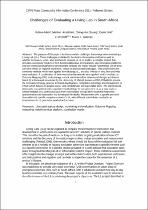JavaScript is disabled for your browser. Some features of this site may not work without it.
- ResearchSpace
- →
- Research Publications/Outputs
- →
- Conference Publications
- →
- View Item
| dc.contributor.author |
Adam, R

|
|
| dc.contributor.author |
Herselman, Martha E

|
|
| dc.contributor.author |
Chuang, CH

|
|
| dc.contributor.author |
Smit, D

|
|
| dc.contributor.author |
Eloff, JHP

|
|
| dc.contributor.author |
Zielinski, MP

|
|
| dc.date.accessioned | 2012-01-25T08:18:22Z | |
| dc.date.available | 2012-01-25T08:18:22Z | |
| dc.date.issued | 2011-11 | |
| dc.identifier.citation | Adam, R, Herselman, M, Chuang, CH et al. 2011. Challenges of evaluating a living lab in South Africa. CIRN Prato Community Informatics Conference, Italy 9-11 November 2011 | en_US |
| dc.identifier.uri | http://hdl.handle.net/10204/5527 | |
| dc.description | CIRN Prato Community Informatics Conference, Italy 9-11 November 2011 | en_US |
| dc.description.abstract | The purpose of this paper is to discuss certain challenges that emerge when evaluating a Living Lab (LL). These challenges are linked to the choice of evaluation methods as well as whether to measure, when, what and how to measure. A LL in itself is a complex context that provides a successful mixture of ICT-based collaborative environments, open innovation platforms, and user centred product/service development methods and Public Private Partnerships. All of these can have effects on regional economies, industries and societal landscapes. This article shares the combined methods which were applied in evaluating a LL and also reflects on why, how and what were evaluated. A combination of three evaluation frameworks were applied, which involved: a) Outcome Mapping (OM) methodology to track user/stakeholder behavioural changes and lessons learnt, b) a framework developed by the University of Madrid, known as OO/UC3M/63 to provide the innovation strategy, process, technical development, competitive advantage and management, c) PACE which focuses on project assets, core competencies and exploitable items. The interpretavist philosophy was applied with a qualitative methodology to use a project’s LL as a case study to collect feedback on a continuous basis from stakeholders through semi-structured interviews, questionnaires and observation and to interpret the results. Measurement over a specific period of time within the specific complex context of a LL with different stakeholders resulted in an improvement in LL processes, product and services. | en_US |
| dc.language.iso | en | en_US |
| dc.relation.ispartofseries | Workflow request;7976 | |
| dc.subject | User participatory design | en_US |
| dc.subject | Living Lab monitoring | en_US |
| dc.subject | Living Lab evaluation | en_US |
| dc.subject | Outcome mapping | en_US |
| dc.subject | Mobile services platform | en_US |
| dc.subject | Stakeholder matrixes | en_US |
| dc.subject | Information systems | en_US |
| dc.subject | Information technologies | en_US |
| dc.subject | Communication technologies | en_US |
| dc.title | Challenges of evaluating a living lab in South Africa | en_US |
| dc.type | Conference Presentation | en_US |
| dc.identifier.apacitation | Adam, R., Herselman, M. E., Chuang, C., Smit, D., Eloff, J., & Zielinski, M. (2011). Challenges of evaluating a living lab in South Africa. http://hdl.handle.net/10204/5527 | en_ZA |
| dc.identifier.chicagocitation | Adam, R, Martha E Herselman, CH Chuang, D Smit, JHP Eloff, and MP Zielinski. "Challenges of evaluating a living lab in South Africa." (2011): http://hdl.handle.net/10204/5527 | en_ZA |
| dc.identifier.vancouvercitation | Adam R, Herselman ME, Chuang C, Smit D, Eloff J, Zielinski M, Challenges of evaluating a living lab in South Africa; 2011. http://hdl.handle.net/10204/5527 . | en_ZA |
| dc.identifier.ris | TY - Conference Presentation AU - Adam, R AU - Herselman, Martha E AU - Chuang, CH AU - Smit, D AU - Eloff, JHP AU - Zielinski, MP AB - The purpose of this paper is to discuss certain challenges that emerge when evaluating a Living Lab (LL). These challenges are linked to the choice of evaluation methods as well as whether to measure, when, what and how to measure. A LL in itself is a complex context that provides a successful mixture of ICT-based collaborative environments, open innovation platforms, and user centred product/service development methods and Public Private Partnerships. All of these can have effects on regional economies, industries and societal landscapes. This article shares the combined methods which were applied in evaluating a LL and also reflects on why, how and what were evaluated. A combination of three evaluation frameworks were applied, which involved: a) Outcome Mapping (OM) methodology to track user/stakeholder behavioural changes and lessons learnt, b) a framework developed by the University of Madrid, known as OO/UC3M/63 to provide the innovation strategy, process, technical development, competitive advantage and management, c) PACE which focuses on project assets, core competencies and exploitable items. The interpretavist philosophy was applied with a qualitative methodology to use a project’s LL as a case study to collect feedback on a continuous basis from stakeholders through semi-structured interviews, questionnaires and observation and to interpret the results. Measurement over a specific period of time within the specific complex context of a LL with different stakeholders resulted in an improvement in LL processes, product and services. DA - 2011-11 DB - ResearchSpace DP - CSIR KW - User participatory design KW - Living Lab monitoring KW - Living Lab evaluation KW - Outcome mapping KW - Mobile services platform KW - Stakeholder matrixes KW - Information systems KW - Information technologies KW - Communication technologies LK - https://researchspace.csir.co.za PY - 2011 T1 - Challenges of evaluating a living lab in South Africa TI - Challenges of evaluating a living lab in South Africa UR - http://hdl.handle.net/10204/5527 ER - | en_ZA |






